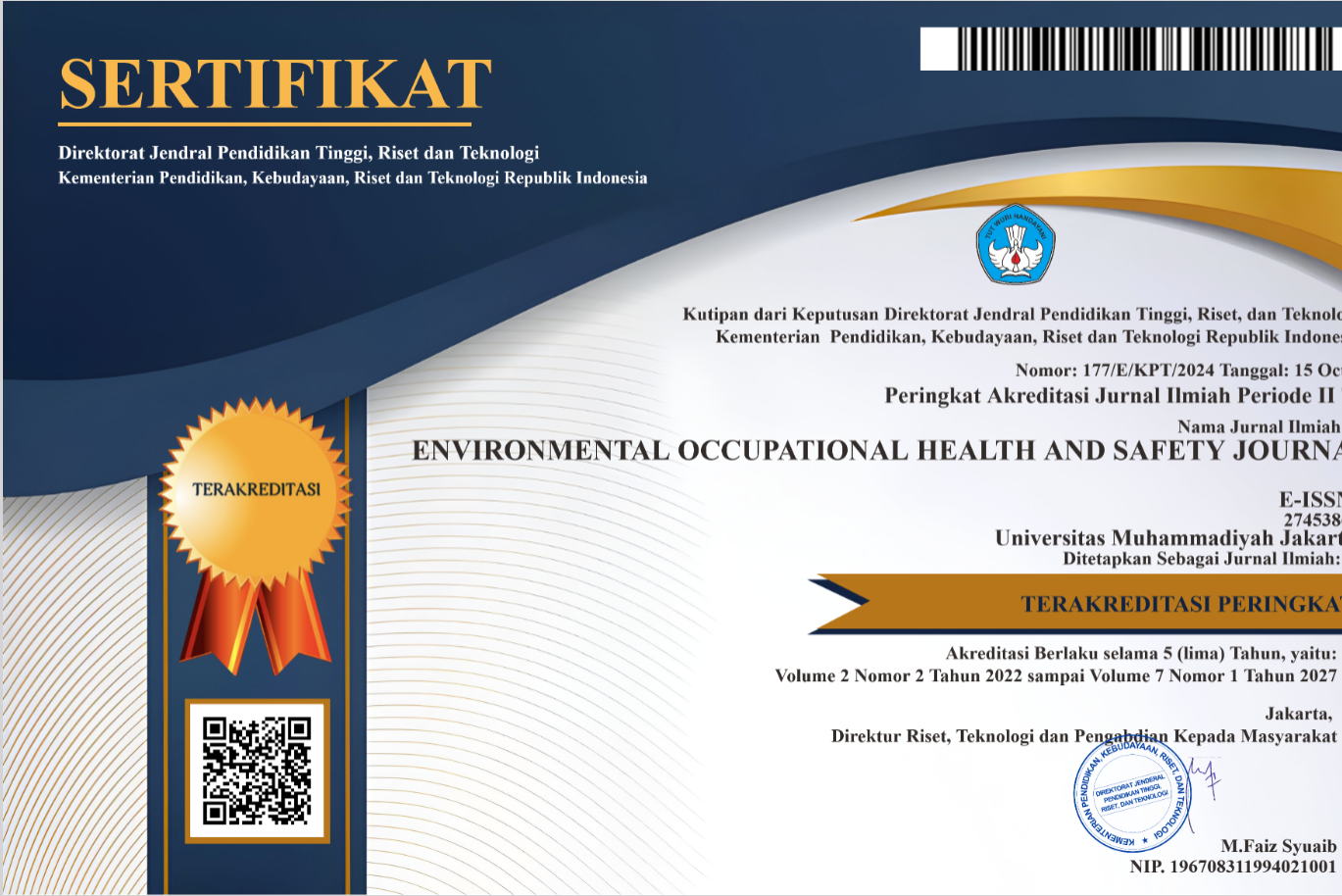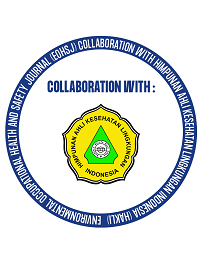Gambaran Umum Pengelolaan Limbah Bahan Berbahaya dan Beracun (B3)di Rumah Sakit Umum Daerah Tebet Tahun 2018
Abstract
Pendahuluan: Penelitian ini bertujuan untuk mengetahui gambaran pengelolaan limbah bahan berbahaya dan beracun (B3) di Rumah Sakit Umum Daerah Tebet Tahun 2018.Metode : Penelitian ini dilakukan di RSUD Tebetpada bulanAgustus 2018. Penelitiandeskriptif dengan pendekatan kualitatif. Teknik pengumpulan data primer dengan observasidan wawancara mendalam. Pengumpulan data sekunder didapat dari instansiserta studi kepustakaan yang terkait.Informan yang diambil berjumlah sebelas orang terdiri dari satu orang petugas sanitasi, lima orang petugas cleaning servicedan lima orang perawat.Hasil: Jenis limbah B3 yang dihasilkan di RSUD Tebet antara lain limbah B3 dengan karakteristik infeksius, limbah B3 jenis benda tajam, limbah B3 jenis patologi, limbah B3 jenis farmasi, limbah B3 yang mengandung logam beratdan limbah tabung atau kemasan bertekanan.Sumber limbah B3 di RSUD Tebet berasal dari Instalasi Gawat Darurat, Ruang Perawatan, Ruang Bersalin, Ruang Operasi, Ruang Poli Rawat Jalan, farmasi, Laboratorium, tempat sampah di toilet, serta di unit IPSRS yang mengelola B3 umum. Rata-rata volume limbah B3 RSUD Tebet Tahun 2018 mencapai 33,20-44,19 kg per hari.Hasil penelitian menunjukkan tahap pemilahan, penampungan / pewadahan,pengangkutan, penampungan sementara limbah B3 di TPS serta pembuangan akhir dan pemusnahanbelum sesuai Kepmenkes RINomor 1204 Tahun 2004 dan Permen LHK RI Nomor 56 Tahun 2015.Saran: Memberikan sosialisasi dan pelatihanpengelolaan limbah B3, melengkapi sarana prasarana pengelolaan limbah B3, mengevaluasi ketiga yang mengolah limbah B3, membuat izin TPS limbah B3, meningkatkan pengawasan, dan seluruh karyawan sebaiknya harus paham dan patuh terhadap ketentuan pengelolaanlimbah B3.
---
Introduction:This study aims to determine the description of the management of hazardous and toxic waste (B3) at the Tebet Regional General Hospital in 2018.Method:This research was conducted at Tebet Hospital in August 2018. Descriptive research with a qualitative approach. Primary data collection techniques with observation and in-depth interviews. Secondary data collection was obtained from agencies and related literature studies. The informants were eleven people consisting of one sanitation officer, five cleaning service officers and five nursesResults:The types of B3 waste produced in Tebet Hospital include B3 waste with infectious characteristics, B3 type ofsharp objects, B3 type of pathology, B3 type of pharmaceutical waste, B3 waste containing heavy metals and tube waste or pressurized packaging. The source of B3 waste in Tebet Hospital comes from Emergency Room, Treatment Room, Maternity Room, Operating Room, Poly Room, Outpatient, Pharmacy, Laboratory, Trash can in the toilet, and the IPSRS unit that manages public B3. The average volume of B3 waste in Tebet Hospital in 2018 reaches 33.20 to 44.19 kg per day. The results showed the stages of sorting, storing / storing, transporting, temporary storage of B3 waste in the TPS and final disposal and destruction not in accordance with the Decree of the Minister of Health of the Republic of Indonesia Number 1204 of 2004 and the Minister of Environment and Forestry Decree Number 56 of 2015.Suggestion:Providing socialization and training on B3 waste management, completing infrastructure for B3 waste management, evaluating the three who process B3 waste, making TPS waste B3 permits, increasing supervision, and allemployees should be aware of and comply with B3 waste management requirements.
Keywords
Full Text:
PDFReferences
Asmarhany, Chandra. 2014. Pengelolaan Limbah Medis Padat di Rumah Sakit Umum Daerah Kelet Kabupaten Jepara, Skripsi: Jurusan Ilmu Kesehatan Masyarakat
Keputusan Menteri Kesehatan Republik Indonesia Nomor 1204/MENKES/SK/X/2004 tentang Persyaratan Kesehatan Lingkungan Rumah Sakit: Departemen Kesehatan Republik Indonesia
Mustika, Dewi, dkk. 2014. Analisis Pengelolaan Sampah Medis Pelayanan Kesehatan Praktik Bidan Swasta Di Kota Banjarbaru: Jurnal Kesehatan, EnviroScienteae 10 : 118-123. ISSN 1978-8096
Peraturan Menteri Lingkungan Hidup dan Kehutanan Republik Indonesia Nomor P.56/Menlhk Setjen/2015 Tentang Tata Cara Dan Persyaratan Teknis Pengelolaan Limbah B3 Dari Fasyankes
Pruss, Annette, dkk. 2005. Pengelolaan Aman Limbah Layanan Kesehatan. Jakarta: EGC
Purcell, John. 2005. Waste Management in Hospitals. Irlandia: Departement Of Health and Children. Diakses 30 Mei 2018. http://www.audgen.gov.ie/documents/vfmreports/49_Waste_ Management _ in_Hospitals.pdf
Rahno, Dionisius. 2015. Pengelolaan Limbah Medis Padat Di Puskesmas Borong Kabupaten Manggarai Timur Propinsi Nusa Tenggara Timur: Jurnal Kesehatan, J-PAL, Vol. 6, No. 1. ISSN: 2087-3522
Rosmawaty, Winnie. 2013. Gambaran Pengelolaan Limbah Medis Tajam Di Rumah Sakit Umum Daerah (RSUD) Kabupaten Bekasi Tahun 2013 Dibandingkan Dengan Kepmenkes No. 1204/ Menkes/ Sk/ X/ 2004 Dan Western Regional Hospitals 2012, Skripsi: Program Studi Kesehatan Masyarakat
Ronald T, Jootje M.L. Umboh, W. B. S. J. (2018) ‘Pengelolaan Limbah Medis Padat Bahan Berbahaya Beracun (B3) di Rumah Sakit Umum Daerah (RSUD) Piru Kabupaten Seram Bagian Barat, Provinsi Maluku pada Tahun 2018’, 7(5), pp. 1–8. Available at: https://ejournal.unsrat.ac.id/index.php/kesmas/article/viewFile/22333/22019.
World Health Organization. World Health Report; 2003
DOI: https://doi.org/10.24853/eohjs.1.1.101-117
Refbacks
- There are currently no refbacks.





